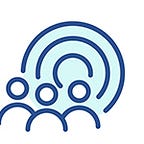Can the “3 L’s” help create healthier organizations?
One of the key challenges for anyone interested in making their work more “human centered” or rooted in empathy and understanding for the people you serve is: it sounds great — but how do you actually do it? How do you translate those things from pleasant-sounding words on a page into something hyper-busy, resource-strapped organizations can actually apply in the real world?
Here at Loup, we had a bit of an “a ha” moment on this challenge after talking with and interviewing network members at the Creative Commons Summit in Toronto. That work encapsulated, in a real human way, exactly what so many forward-thinking organizations are focusing on right now: taking a more collaborative, network-based approach to tackling big challenges, and — crucially — doing that by better understanding and elevating the stories of their members.
From stories to learning and analysis
What was even more encouraging was what happened *after* the event. CC colleagues saw the stories we collected not just as a one-off or communications exercise — but as a source of valuable human data for ongoing exploration and follow-up. In areas like:
- How to strengthen their value proposition for the network
- How to feed member feedback and insights into a new accessibility program
- How to leverage the stories in creative new ways through transcription, podcasting and beyond.
Making it stick: “Listening, Learning and Labs”
As we reflected more after the event about the secret sauce that made the work feel particularly successful, Christine had a bit of an “a ha” moment. The key ingredients that make this kind of work really “stick” for organizations are a combination of methods and mindsets coming together in a complementary way; three key muscles that flex together to create momentum and follow-through. They’re a combination of:
- Listening — deep listening with the people you serve. Inviting them to tell stories about their experiences, share stories about successes, and open up about the challenges they’re facing.
2) Learning — translating those stories into actionable insights and analysis. Extra elbow grease is required here — otherwise, they’re just a collection of stories that sit in a database or a bunch of blog posts / audio files. There’s valuable *data* in these stories — but first it needs to leveraged and captured and distilled.
3) Labs — translating that analysis into action in the org through powerful *experiences* for the people doing the work. Not just another thing to read, or another presentation to sit through — but the kind of “a ha” that only happens through hands-on experience.
The whole of our Human of the Commons at the CC Summit functioned like this — a giant hands-on experiential laboratory for people to choose their own adventures and weave together powerful experiences for themselves. We see a ton of innovation happening in this space, from our inspiring colleagues at e-180, to the frenetic creativity of the Mozilla Festival, to the participatory projects, workshops and trainings we’re providing to organizations like IREX, PASE and others.
More and more, we’re encountering people throwing off the limits of dull meetings and stale conference formats to get to something more human and exploratory. We are all (whether we think of it this way or not) in the human *experience* business, and if we want people to learn or discover or make a change, it’s all about designing and facilitating a powerful experience for them. Not just shoving another to-do or takeaway at them. We like the word “labs” for this; it communicates exploration and getting hands-on, and ideally: creative elements combusting together in unpredictable ways.
What do you think?
We believe these general “listening, learning and labs” categories can work for anyone. They provide a simple framework for thinking through organizational change, kickstarting innovation, strengthening your network, or building capacity and engagement for staff. But we are still asking:
1) How do we listen? 2) How do we translate that listening into learning? And then 3) how do we create powerful experiences for people that helps them explore and act on that learning?
We know working and sharing openly with broad and connected networks is simply more effective. When we share what we’re learning, we increase our impact, make it easier for others to help, and tap good ideas that come from anywhere. Read Alecia Kuhl’s blog post about Loup’s journey in Mozilla’s Open Leaders program.
So in that spirit, we wanted to think out loud on this and compare notes with fellow practitioners. In the coming weeks and months, we’ll share more about the specific work we’re doing in each of these three “Learning, Listening and Labs” buckets, along with reflections and learnings coming out of our team retrospectives. So watch this space!
